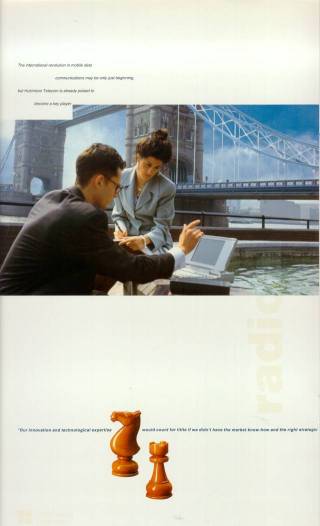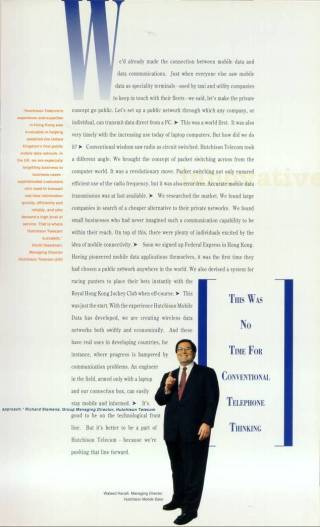The end result was the formation of Hutchison Mobile Data Limited (HMDL), with Hutchison Telecom owning 70%, Rick Seimens 20%, and myself 10%, and the position of Managing Director. A licence was granted for spectrum in the 800 mhz band, and we were in business.
The ability to carry 10% of the capital costs of a rapidly growing infrastructure company quickly expired. Although I had done well in the PC business, I did not have the funds or credit to fund my share. As a young Canadian civil servant, one does not accumulate wealth, nor does one tend to have relationships with bankers prepared to lend without collateral. I managed to hold on until the serious bills started arriving. Luckily, Hutchison around this time was consolidating its control over a number of the telecom businesses that had been acquired or started with partners. I sold my share, and remained as the MD, while Motorola came in as a shareholder with 30%.
The Company developed rapidly at this point, with offices being set up on the same floor as HTL in the Citibank Tower in North Point. Given that most of the equipment for the wireless packet data network was in the field in the form of transmitters and antennas, the decision was made to have the data centre in the same offices as the staff.
Early employees came from my PC software business which I now turned down and morphed into HMDL, and I recruited my first technical engineers and salesmen.
The MDI people "got it", and understood that I wanted to build something radically different from a normal vehicle dispatching system. We needed to create a wireless "fabric" that covered the city, connected to a conventional data switch that would allow connections to all the various flavours of machines run by potential customers. Remember that this was before the public Internet, before Cisco, and before TCP/IP meant anything to 99.9% of the people in computing. The word packet meant X.25, and those packets travelled on X.25 networks at 64K, typically.
During my familiarization tour of Canadian companies before being posted to Hong Kong, I had met a company called Develcon in Saskatoon. They had impressed me with their technology and vision, and I had helped them get an agent in Hong Kong, a company called Data 100 run by Bob Cochrane. One of their products was a multi-protocol data switch that allowed one to connect pretty much anything to anything. This was pretty revolutionary stuff, and NASA had become their customer, deploying hundreds of the switches. I introduced the Company to MDI, and the Develcon switch became the main customer connection point for network.
The team at MDI was busy working on the software project to convert their existing taxi dispatch software into something more generalized - a software switch that would be able to handle multiple hosts talking to thousands of remotes. And they did it. Led by Cameron Fraser, and his brilliant programming team, the software gateway, running on a DEC MicroVax, was delivered.
Unfortunately, things were not going so well on the portable device side. Hong Kong is an extremely urbanized environment, and it had been clear from the start that an English language terminal for Canadian police cars was never going to sell. We needed a portable terminal that could display multiple languages, and a device that acted as a packet modem to connect other existing terminals.
In what became an unfortunate and ultimately fatal series of events, MDI would promise a device with drawings, mock-ups, and delivery dates, then fail to deliver. We had a network, but we didn't have the "phones" to put on it.
To complicate matters even further, MDI was acquired by Motorola. Motorola was a major supplier to Hutchison Telecom for the celluar and paging businesses, and was my shareholder. Now they owned my supplier. And they hadn't forgotten that I had chosen MDI instead of their mobile data technology.
Much noise, angst, email, threats, and meetings ensued. Motorola proposed ripping out the MDI system and putting in the system I had originally rejected. Motorola's system had never found a customer after the original IBM deal, and had some technical limitiations that I found unacceptable. I was also intimately familiar with the MDI technology and people by this time, and did not want to start all over.
Motorola finally agreed to continue the MDI platform, which ran a protocol call MMP, but their team in Schaumberg also got the right to keep working on their legacy system. The decision to keep both platforms in what was a niche market institutionalized conflict and distracted Motorola for years to come.


